Category Archives: Horticulture
Vegetables and Lawns
Wishing everyone a blessed Easter! While I won’t get to it this year, there are people like me who traditionally plant potatoes on Good Friday. So, that led me to thinking of lawn and garden things. A vegetable planting guide for our area compiled by Emeritus Extension Educator, Gary Zoubek can be found here: https://go.unl.edu/fecq.
Kelly Feehan, Extension horticultural educator shares, “Late March through April is typically the time to plant cool season vegetables. These vegetables germinate and grow in cooler soils and can tolerate light frosts. They include onions, potatoes, radish, lettuce, carrots, beets, peas, broccoli, and cabbage.
A tip for growing large onions that store well is starting from transplants instead of sets. Plants grown from sets may begin blooming in mid-summer. Once this happens, bulbs will not grow larger. Flowering happens because onions are biennials. They grow foliage and a bulb the first season, then bloom and set seed their second season. Growing sets for sale counts as one season and so plants from sets are primed to bloom when growth resumes in our gardens.
When growing onions from seed or transplants, plants are not primed to bloom the year we plant them. Some garden centers and catalogs now sell onion transplants for this reason. If you prefer to start from sets, use dime size or smaller sets as these are less likely to bloom the year of planting.
Potatoes are planted in April, sometimes late March or early May. A tip for increasing potato yields is hilling potatoes after they begin to grow. Once they are 12 to 20 inches tall, carefully scrape soil up around the plant to create a hill.
Potato tubers grow on stolons, underground stems, above the roots. Hilling provides more space for tubers to grow and maintains cooler soil temperatures, especially if hills are mulched. As a cool season crop, cooler soil will increase tuber production.
If potato hills are spaced closer together, tubers grow smaller. If hills are spaced farther apart, tubers grow larger. The recommended spacing is 12 inches between hills and 3 feet between rows. The 12-inch spacing will result in smaller tubers. An 18 to 24 inch spacing will result in larger tubers.”
Soil Temperatures can be found at: https://cropwatch.unl.edu/soiltemperature. This is helpful for knowing when to plant vegetables, when to plant crops, and what the soil temp is when applying fertilizer to fields. It’s also helpful for homeowners to wait to apply crabgrass preventer for lawns until soil temps are at least 50-55F for 5-7 days straight. In spite of the warmer temps, it’s far too early for crabgrass preventers!
Lawn Seedings: For those who didn’t seed or overseed turf grass last August-September due to the dry conditions, aim to seed or overseed as soon as possible. Weed control can be a challenge with spring seedings, but a new product has helped with this. I tried it last year and it worked well for me. Just know that your weeds will turn white in the lawn. “Scotts Turf Builder Triple Action Built for Seeding” (blue bag) contains fertilizer and the herbicide mesotrione which provides PRE and POST control of weeds without affecting the new bluegrass or fescue seeding.
Male birds: To keep male birds from attacking your windows upon seeing their reflection when they’re establishing territories, consider placing a thin layer of liquid dish soap on the outside of the window. It can easily be washed off in late spring but will protect your windows and the male birds.
Japanese Beetle Organic and Conventional Products Found Locally
With the Japanese beetle invasion in the area and their territory spreading further each year, I checked with local retailers (nurseries, lawn/garden centers, farm stores, Wal-Mart, Ace) to see what they have on hand to hopefully be of help.
First, Please Read the Label on any product before you purchase it to make sure:
1: the product says it controls Japanese beetle adults
2: the product is labeled for where you wish to apply it (vegetables, trees, ornamentals, fruit trees, berries, etc.)
3: follow all pre-harvest intervals (PHI) for when you can safely harvest vegetables, fruits, and berries after a product is applied.
Last year I had to unfortunately tell three people they couldn’t eat the produce from their gardens due to the product they sprayed.
Second, there are a number of insecticide options available. Know that most anything applied to flowering plants will also impact pollinators. For flowering plants like roses, cannas, etc., knocking the beetles off around 7 p.m. in the evening into soapy water will protect pollinators visiting them.
There are also ready to use and concentrate versions of chemicals available. The easiest are ones where you simply attach the garden hose and spray. Others need to be mixed with water into a sprayer.
Organic Insecticide Options include Neem, Pyola, Spinosad Soap, Pyrethrin products (ex. Beetle and Boxelder bug killer), and Bt. Neem may repel more than kill Japanese beetle adults. These products will all last around 3-7 days and will need to be reapplied. Products containing these active ingredients should be safe on fruits, vegetables, in addition to using on flowers, shrubs, and trees. Be sure to read and follow directions as there may be a temperature restriction on applying some of them that contain oils to avoid burning leaf tissue.
Conventional insecticide Options can provide up to two weeks of control. I’m going to separate these into products I found locally based on the location they can be applied. Ultimately, this is NOT a complete list and many other products can also be found online. There are also products containing insecticide + fungicide that I don’t list here. Please be sure to read the label for yourself as to the insects controlled and where it can be applied before purchasing.
1. Ornamental shrubs, plants, trees (like linden, elm, birch): DO NOT use these products on vegetables, fruits, or berries. Hi Yield 38+ and Tempo. There’s home defense products labeled for Japanese beetle adults but they don’t mention they can be applied to trees or shrubs.
2. Vegetables, fruits, ornamentals, shrubs, trees: BioAdvanced Rose and Flower Insect Killer, BioAdvanced Tomato and Vegetable Insect Killer, BioAdvanced Vegetable and Garden Insect Spray, Eight, Spectracide Acre Plus Triazicide Insect Killer, Hi-Yield Lawn/Garden/Pet/Livestock Insect Control, Sevin, Ortho BugClear, and Ortho Bug B Gone.
Many of the conventional insecticide products contain pyrethroids such as bifenthrin or permethrin. Thus, there are also products that just say ‘bifenthrin’ or ‘permethrin’ that can also be purchased. Be sure to read the label as some have restrictions such as “can’t be applied to apples” while others can.
JenREES 6/26/22
It’s a beautiful Sunday afternoon as I write this from my deck! Looking in my backyard I see one new rose blossom, leaves appearing on my vegetables, perennials, and bare areas of trees again, and beauty from a couple annuals I planted yesterday from plants that didn’t recover. As I worked with farmers the past few weeks, similar words kept surfacing in conversations: exhausted, sadness, numb, discouraged, so much loss, at least I wasn’t the only one, frustrated, angry, anxious, stressed, was thinking it’d be a good year, he/she had it worse, thankful for insurance, hopeful. And, I share that because you’re not alone in these thoughts and feelings. There’s been a tremendous amount of loss; sharing with others can help with healing. There’s been a range of emotions experienced in destroying what remains of old crops and driving to non-affected areas. Also, hope as beans, corn, and sorghum have emerged from the ground in 3 to 6 days. Praying we can finish the season well.
For those with gardens, there’s new life from buds developing on tomato, pepper, potatoes, eggplant, beans! Onions shot new leaves. My rhubarb went from a mushed mess to new leaves coming now. I had just left everything alone and yesterday removed the mushed, rotted rhubarb and replanted beans and carrots. Some have tried to help their hostas by cutting out dead once it dried. Many perennials reduced to sticks are trying to shoot new leaves. We will have to watch trees.
For those with good crops, I received a report of a first tassel in southern counties. Also, northern corn leaf blight from a consultant, so perhaps watch for that. Japanese beetles have arrived; I’m not talking about problems this week!
Have received two areas of cover crop questions: weed control in existing low corn populations and annual forages after a totaled out crop. If grazing/haying, please check the herbicide label. For example, the Resicore label specifies to ‘not graze or harvest rotational cover crops for food or animal feed for 18 months following the last application of Resicore.’
1—Weed control: For simplicity, low growth, low cost, quick shading I’d recommend brassica species such as forage collards, turnips, etc. They can be seeded now, or you can wait 3 weeks from when residual herbicide product was applied to the field. If you’d like a grass, annual ryegrass could be added; should survive the winter. Clovers could be added to provide N next year; should survive the winter. Ultimately just depends on your goals. I prefer drilling between the corn rows, but there are broadcast options that can cover acres faster. Our interseeding team will drill blocks of 5 to 10 acres of our small seed mix (brassicas, clovers, flax, ryegrass) for those interested in trying it (let me know asap if interested). Another project: several NRD’s including UBBNRD in partnership with UNL plan to apply covers via a high clearance machine around beginning dent in corn (targeted around eastern Beaver and Lincoln Creeks; contact UBBNRD if interested).
2-For those considering summer annual forages, if your fields got totaled or in the event your seed corn acres aren’t kept, here’s some ideas and tradeoffs. Sorghum sudangrass (4.2-5.3 T/ac), forage sorghum (4.4-5.3 T/ac), and sudangrass (4.1-4.8 T/ac) are some annual forage options. Sudangrass is an option for grazing due to its low prussic acid potential. Sorghum-sudangrass plants get tall and are suited well for greenchop. Forage sorghums are also known as ‘cane’ due to their sweet stems and are suited well for silage. They have higher prussic acid potential, so we don’t recommend grazing them. For those looking at haying followed by grazing, I’d recommend pearl millet (3.8-4.5 T/ac). It doesn’t get the tonnage of the sorghum species, but the stems are thinner for haying and you don’t have to worry about prussic acid poisoning in the regrowth when you graze it. It worked well for my uncle and dad on their prevent plant farm in 2019 and the cattle loved it. This publication goes into more detail regarding all these species, seeding rates, how to graze and hay each, etc: https://go.unl.edu/7ivw. If you’re interested in haying, I don’t recommend adding any other species to these as we’ve found it causes issues with drydown and with bales heating up. Rye (or wheat) could then be planted this fall/winter if desired.
Weed Management Field Day at UNL’s South Central Ag Lab is this week on June 29th near Clay Center (9 a.m.-1 p.m.). Great information including a second year research project of the same herbicide programs for corn and soybean when rye is terminated 2 weeks prior to planting vs. 2 weeks after planting. It’s interesting to see in the field, so hope you can join us! No cost, free lunch, please RSVP: https://agronomy.unl.edu/weed-management-field-day-registration.


New soybeans alongside old sticks. Emerged in as little as 3 days. New corn in the old corn grower plot.


Part of my garden on June 15, 2022 the day after the hail events. I left it alone.


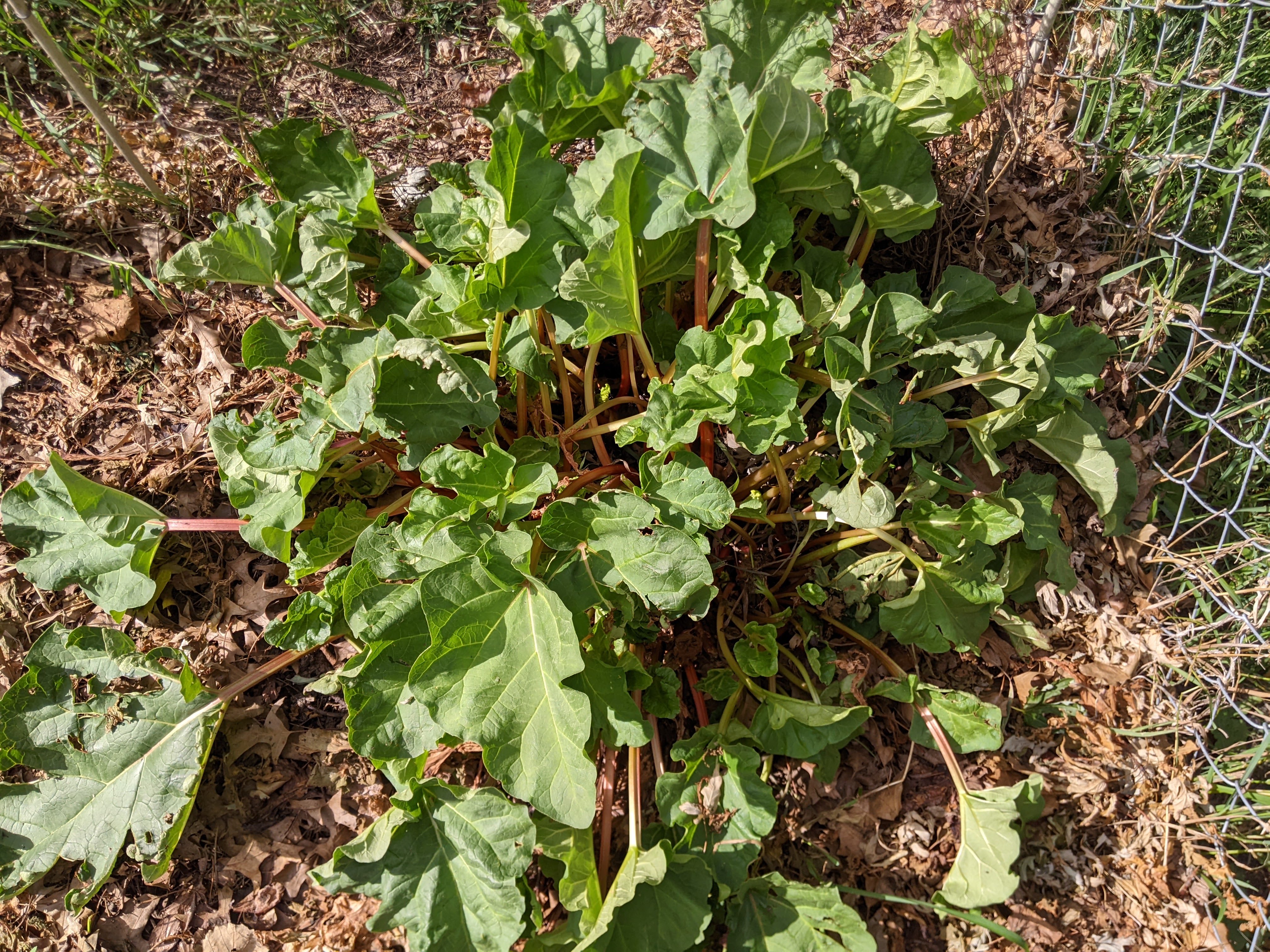

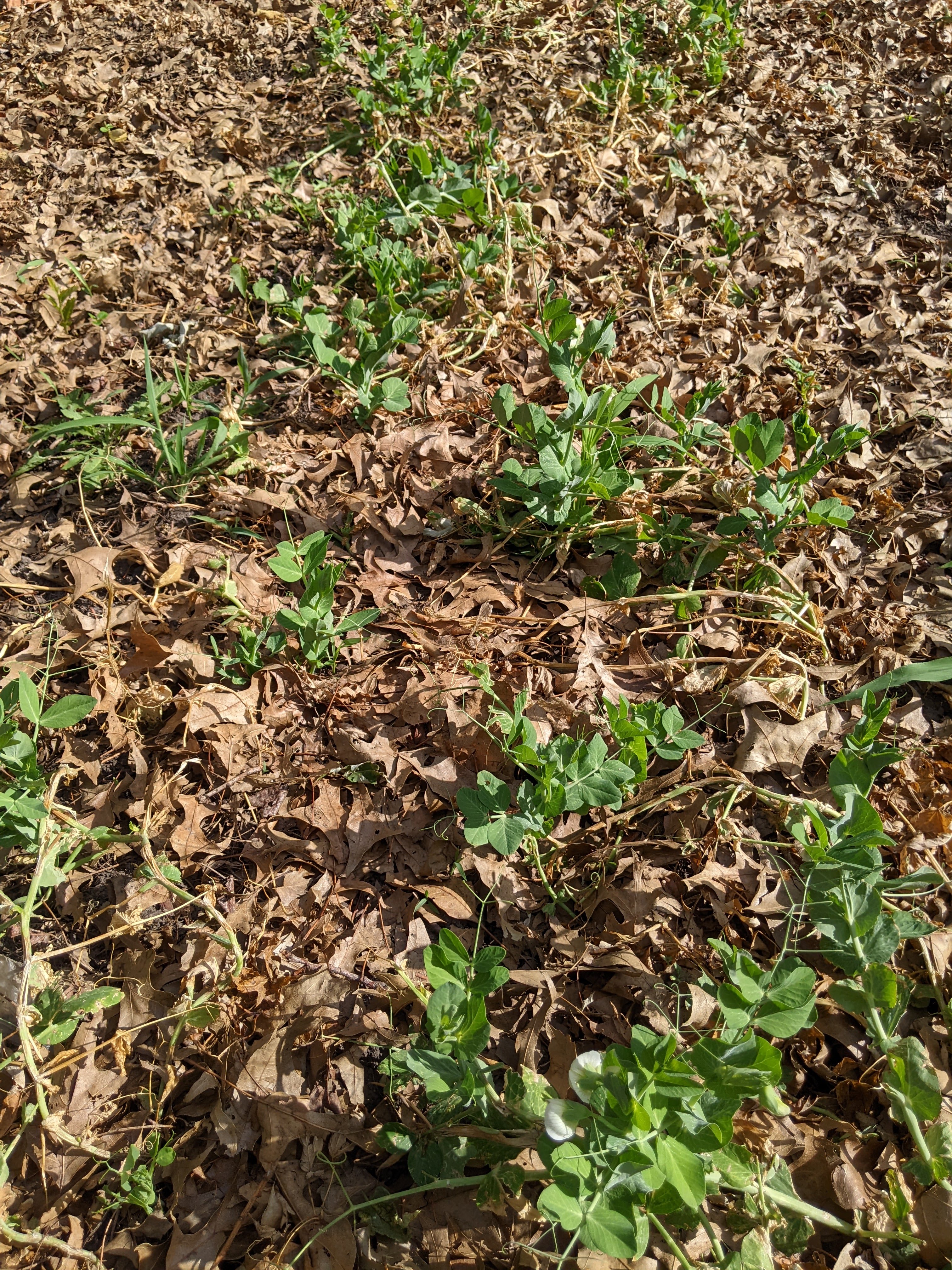
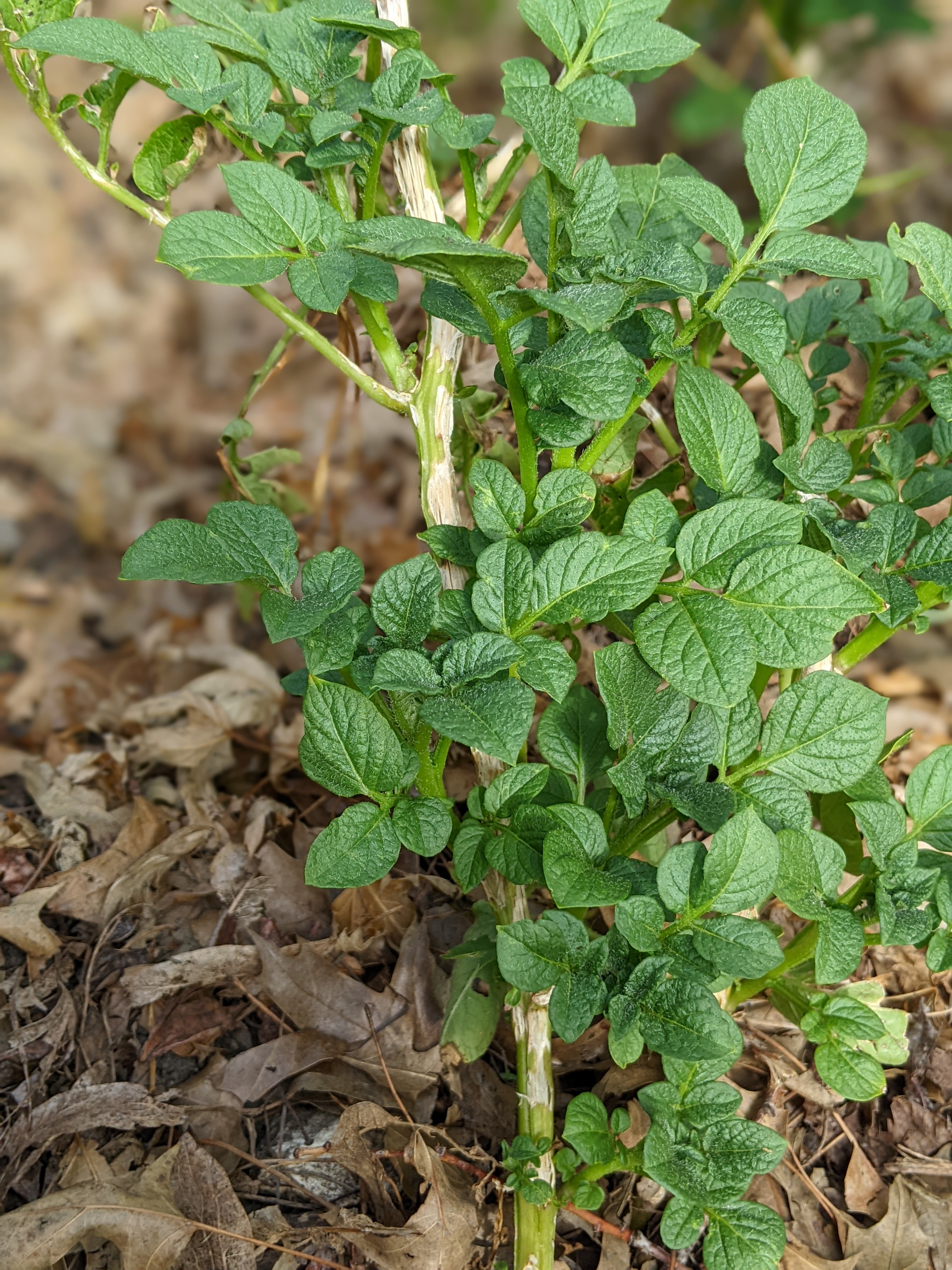
June 25th, 2022: New growth on most everything. Very few beans and none of my carrots survived. Rhubarb looks like a new plant again after removing the mushy, rotted growth and with the new leaves. Tomatoes, potatoes, peppers, eggplant came back from stems. Can see the hail damage on the stems. Onions shot new leaves out the top. Also had a new crop of asparagus come on. Need to re-stake remaining peas and will see what happens with them. Potatoes are all leaned over now instead of growing upright.

“…to give unto them beauty for ashes, the oil of joy for mourning, the garment of praise for the spirit of heaviness; that they might be called trees of righteousness, the planting of the Lord, that he might be glorified.” Isaiah 61:3 KJV
This is one of my favorite Bible verses and promises from God in the midst of hard things and I like this translation of it since it specifically says ‘beauty from ashes’. May we all look for the beauty in the midst of the ashes around us this week. And, I believe God is also desirous of creating beauty from ashes in all of our lives!
JenREES 2/27/22
Growing Fruit in the Home Garden: The GROBigRed Virtual Learning Series from Nebraska Extension kicked off last week with a 6-week series ‘Growing Fruit in the Home Garden’. Join us at 6:30pm CT each Thursday for two short presentations and an opportunity to ask your pressing garden questions. Register for this free program at https://go.unl.edu/growfruit. Upcoming programs include:
- March 3: Selecting & Buying Fruit Plants and Soil & Fertility
- March 10: Site Selection & Design and Edible Landscapes
- March 17: Brambles (Blackberries, Raspberries, etc) and Grapes
- March 24: Pome Fruits (Apples & Pears) and Stone Fruits (Peaches, Cherries, & More)
- March 31: Strawberries and Unusual Fruits
Soil Temperatures: With March around the corner, a reminder of our CropWatch soil temperature page at: https://cropwatch.unl.edu/soiltemperature.
Farm Bill Decisions: I shared some considerations in the following article if it can be of help as you make these decisions: https://jenreesources.com/2022/01/23/farm-bill-decisions/
Lawns and Gardens: In spite of warm stretches, it’s way too early to consider lawn fertilizer and crabgrass preventer. Wait till April when soil temperatures are expected to be 50F for at least 5 days.
Vegetable planting guide can be found at: https://go.unl.edu/pao8. Kelly Feehan, Extension Educator shares, “For vegetable gardeners, it’s time to think about cool season vegetables. Focus on garden planning, seed buying, and soil preparation, like incorporating compost, if soil is not too wet. Do not let air temperatures trick you into planting too early. It is soil temperature that to determine when to plant. Gardeners who plant too early often end up harvesting later than those who wait. And some gardeners end up replanting since seed can rot in cold soils and seedlings or transplants may be damaged by spring frost. Even if all goes well, seedling emergence can take 10 days or much longer in cold soil. For cool season vegetables like lettuce, radish and peas, wait to plant seed until soil temperatures are above 40 degrees Fahrenheit, with 45 to 50 being ideal.” A meat thermometer designated for soil temperature use is a great way to check soil temperatures.
Small Grain Silage: Last year, four producers allowed me to collect small grain silage samples from rye and triticale so we could get a better understanding of quality in regards to growth stage when cut, moisture, how packed, etc. With short forage supplies, this may be of interest to those who have planted rye/wheat/triticale and have cattle. On March 17h, from 8:30 a.m.-4 p.m., Nebraska Extension, Lallemand Animal Nutrition and Iowa State University Extension and Outreach are hosting the fourth Silage for Beef Cattle Conference. Registration is free and producers have the option to either stream the conference online or attend in-person at the ENREC near Ithaca. Pre-register to join in-person or virtually at: HTTPS://GO.UNL.EDU/SILAGEFORBEEF2022. Topics and speakers will include:
- Agronomic management of small grains for silage, Daren Redfearn, UNL
- When to harvest small grain silage, Mary Drewnoski, UNL
- Sorghum silage: a solution for limited water, Matt Atkins, Wisconsin Dairy Specialist
- Why fermentation analysis is important & what it means, John Goeser, Wisconsin
- Fungamentals of silage harvest management, Becky Arnold, Lallemand Animal Nutrition
- Inoculants for small grain silage, Limin Kung, University of Delaware
- Economics & ROI on quality forage in grower & finishing rations, Jhones Sarturi, Texas Tech
- Making small grain silage work, producer and nutritionist panel

Japanese Beetles
Japanese Beetles: Areas of the State have seen Japanese beetles for a few weeks. They’ve shown up strong in the York/Seward county area this past week with the number of calls I’ve received.
Unfortunately they cause two problems. The larvae are grubs that can impact our lawns.  The adult beetle is ½” in length with a metallic green head and white ‘tufts’ that look like spots on its abdomen. Adults emerge from grassy areas like lawns, ditches, and even fields; however, they don’t emerge at the same time. They emerge over a 4-6 week period beginning in late June and last for around 4-6 weeks. There’s one generation per year. Adult beetles feed, mate, and lay eggs in lawns and grassy areas. The eggs hatch 10-14 days later into grub larvae and feed on turf and grassy areas in the August time-frame. They also over-winter in turf and grassy areas.
The adult beetle is ½” in length with a metallic green head and white ‘tufts’ that look like spots on its abdomen. Adults emerge from grassy areas like lawns, ditches, and even fields; however, they don’t emerge at the same time. They emerge over a 4-6 week period beginning in late June and last for around 4-6 weeks. There’s one generation per year. Adult beetles feed, mate, and lay eggs in lawns and grassy areas. The eggs hatch 10-14 days later into grub larvae and feed on turf and grassy areas in the August time-frame. They also over-winter in turf and grassy areas.
Adults feed on 300 plant species, but their favorites are ones that are in many of our
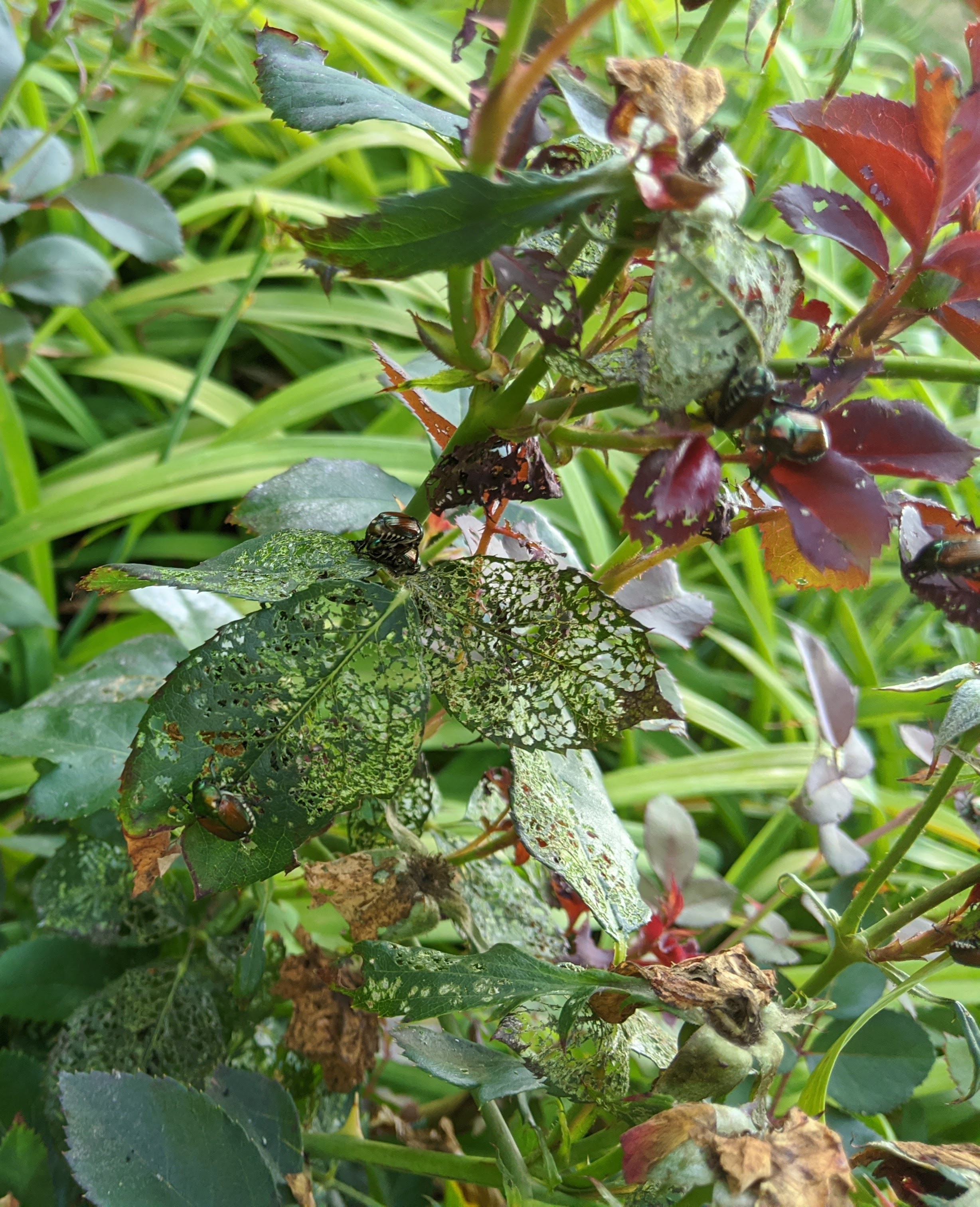
Japanese beetles making quick work of my knockout roses. In this garden area, they are also impacting my cannas but not my lillies, beesbalm, salvia, milkweed, or sunflowers.
landscapes (roses, cannas, marigolds, grapes, Virginia creeper, and trees such as lindens, birch, Japanese and Norway maples, cherry, plum, peach, American elm). They also feed on soybean and corn crops. They love hot weather and full sun and feed on leaf tissue during the day (leaf tissue will look skeletonized or lacy and turn brown). Trees may be severely impacted with browning occurring from the top to bottom. Thankfully healthy trees will re-leaf next year since the underlying twigs and branches aren’t damaged-even if the entire canopy is impacted this year. It’s not recommended to remove branches or trees.
DO NOT use Japanese beetle traps!!! Research shows they attract beetles to the landscape and many homeowners I’ve talked with will attest to this!
Beetle Control: Wait till dusk (7-9 p.m.) before trying to control beetles as they are less
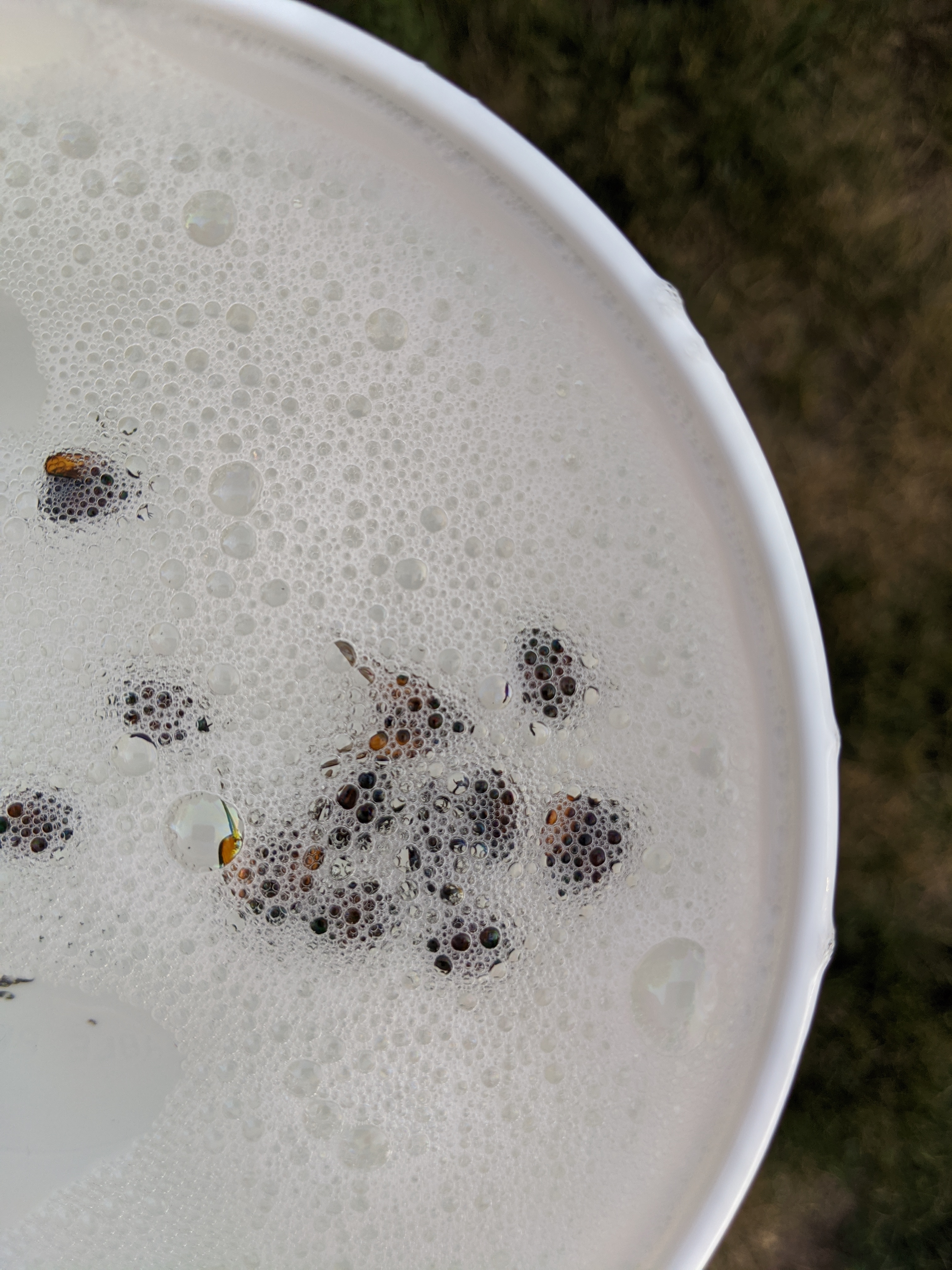
One control option: Wait till 7-9 p.m. then drown Japanese beetles in soapy water after removing them from plants. This method of control takes diligence over several nights.
active then and to reduce impact to pollinators. Organic means include hand-removing beetles by knocking them into soapy water. You can also spray trees with water to knock them down to the ground and then drown in soapy water. This takes diligence over many days. With heavy beetle infestations, it’s not uncommon to literally have scoop shovels full of the beetles when removing from trees. Neem and Pyola are two organic sprays that will protect for 3-7 days. Applying these products regularly (once per week) can also be effective as a repellent.
Japanese beetles often impact the same flowering plants that other pollinators visit. Use insecticide products correctly to avoid damage to pollinators. Avoid spraying insecticides on windy days or when pollinators are present (best to spray late in day near dusk) and be sure to read and follow all label instructions and harvest intervals (for cherries, plums, etc.). Conventional insecticides can provide 2 weeks of control: pyrethroid products like Tempo and Bayer Advanced Lawn & Garden Multi-Insect Killer (cyfluthrin) or Ortho Bug B Gone (bifenthrin). Sevin (carbaryl) is another option although more dangerous for bees.
Grub Control: Turf damage can be evident in Aug./Sept. Products that control common white grub can also provide control of Japanese beetle grubs and should be applied mid-to-late June. Dylox can be used as a rescue treatment if grub control is needed later on and no grub products were applied in the spring.
Next Year: Systemic products like imidacloprid can be used as a soil drench around plants (apply around Mother’s Day). These products can’t be used on Linden trees. You may also wish to swap out more susceptible plants for those less susceptible as you observe which plants they tend to impact most in your backyard.
Also seeing green June beetles and this shows the difference between them and Japanese beetles. Green June beetles don’t have the same impact on leaf damage. They do lay eggs in turf which become grubs as well.

Green June Beetle (left) and Japanese beetle (right). Photo via Purdue Entomology.
JenREES 6-14-20
Storm damage resources: Have had a number of calls throughout the State this week
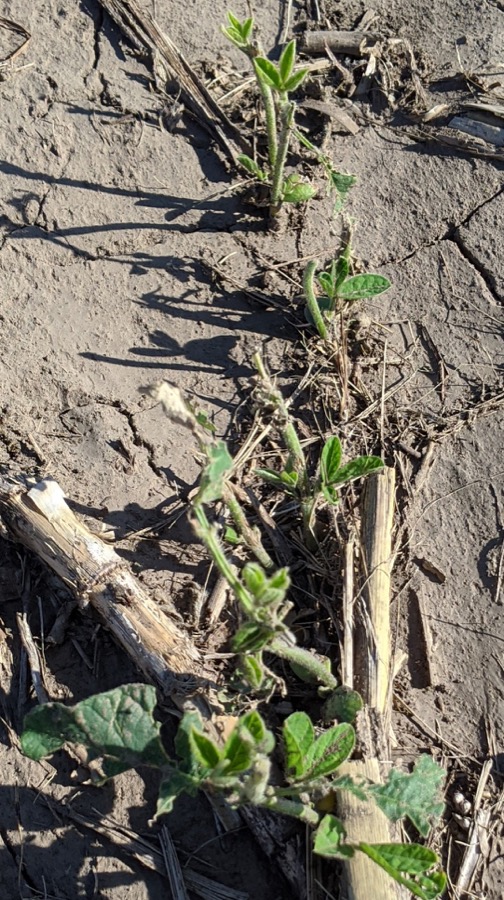
Soybean recovering from hail damage.
from those who have experienced hail, flooding, and/or wind damage. The warmer temperatures were helpful for regenerating plant growth after hail; however, they’re not helpful for those who had heavy rains and flooding that didn’t recede. I shared this last week too but here’s a Hail Damage Assessment resource with many videos: https://cropwatch.unl.edu/hail-know/assess-my-damage. For flooding, corn plants prior to V6 can survive under water for 2-4 days if temperatures do not exceed 77°F. From V7-V10, plants can survive 7-10 days if temperatures do not exceed 86°F. For soybeans, yield losses are minimal if flooding lasts less than 48 hours. If flooded for 4-5 days, fewer nodes develop and plants will be shorter. If flooded for 6+ days, possible stand and yield loss. The longer it takes a field to dry out, the more yield loss that may occur. For soybeans at flowering, there’s potential for yield loss, especially on poorly drained soils.
As we deal with corn leaf loss due to natural sloughing off, early frost, and recent hail
and wind damage, it can make corn development staging tricky for post- pesticide applications. The reason I keep emphasizing development stages is because I’ve been called out to many ear formation concerns the past several years. No one intends for these things to happen! These are opportunities for all of us to learn. In all cases, mis-diagnosis of development stage occurred prior to the pesticide application (whether herbicide, insecticide and/or fungicide). The use of non-ionic surfactant (NIS) in the tank from V10-VT resulted in the ear formation issues in addition to increased surfactant load from multiple products in the tank mix. My hope in emphasizing corn development staging this year is to hopefully reduce the incidence of ear abnormalities that occur from post- pesticide applications. I put together the following video to hopefully help: https://twitter.com/jenreesources/status/1272370173853470720?s=20.
Gardening 101 resources: A team within Extension pulled together all the vegetable gardening resources to create a one-stop place for vegetable gardening. This resource, housed on the backyard farmer website, is a place for beginning gardeners and experienced ones. Check it out at https://go.unl.edu/veggies101!
Sunscald/scorch on green beans: This past week I received a few pictures of green beans that had large brown ‘burnt looking’ areas. This is caused by sunscald. The sun and wind has been intense. Seek to evenly water and avoid watering the foliage.
Trees: Lots of tree questions past few weeks. If leaves are pre-maturely turning yellow and dropping, it’s most likely due to fungal disease. This is mostly happening since the 3” rain over Memorial Day. All the trees I’ve looked at are already starting to develop new leaves. Weed whackers cause more injury to trees that one realizes, so be very careful using them around trees, or put mulch around them to reduce weeds. Remove ‘mulch volcanoes’ around trees as the mulch against the trunk can cause rot. Mulch should not be piled against the trunk. Seek to make clean and proper pruning cuts for all the storm damage that has occurred to trees. For those who’ve experienced bark removal from lightning strikes or winter cracking, don’t paint anything over the wound and don’t fertilize or do anything to the tree. Allow the tree to seek to heal on its own. It’s amazing what trees can overcome! Winter and spring dessication injury may be causing evergreens (cedars, junipers, yews, and arborvitae) to suddenly turning brown. Kelly Feehan, Extension Educator shares, “During warmer than average temperatures in February and March, moisture was lost from green needles and could not be replaced from frozen or cold soils. This was followed by a dry spring; and then above average temperatures and extreme winds. These conditions increase the rate of transpiration and increased moisture loss from needles. If the moisture is not replaced quickly, tissues dessicate and eventually die. Evergreens growing in open exposed sites, near pavement or light colored houses, and those planted in the last three to five years are most susceptible. Other than using organic mulch and keeping soil moist, there is not much to do. Once an evergreen or a branch turns completely brown, it will not recover.” You can prune out dead branches/areas and see how the plants overall recover.
JenREES 5-31-20
Corn: I really enjoy this stage when corn is just tall enough to give the fields a green cast when looking at them from an angle. There continues to be discussion and questions about uneven corn emergence. Like many, I wasn’t anticipating seeing uneven emergence after having great soil conditions (right moisture and a warming trend of temps) for planting. Variations in soil temp, depth, and moisture can delay germination from a few days or longer. Residue blowing back over the row explained much difference in emergence this year. I wish I would’ve noted the days on my calendar, but there’s a couple warm days in late April during planting where it just seemed like the moisture rapidly left the soil surface. And, in conversations it seems as if others noticed that too. So I think moisture around seed was another factor as was fertilizer burn in some situations. Purdue University has some research which showed yield reductions of 6-9% for plants emerging 1.5 weeks later than a uniformly emerging stand. They also found yields of uneven stands to be similar to planting the stand 1.5 weeks later.
If you’re side-dressing nitrogen and interested in testing different rates, we have some on-farm research protocols available at: https://go.unl.edu/tv63.
With warmer temperatures anticipated, corn will grow rapidly. This week we wrote an  article in CropWatch regarding proper growth staging of plants; this will be extra critical once we hit V6+. Remember to use the leaf collar method and this is how I explain it. A collar develops at the leaf base near the stalk after each leaf fully expands. Think about collars like the collar on a button-down shirt. The collar flares slightly at one’s neck, just as a true exposed leaf collar flares at the base of the leaf at the stem. Start counting leaves at the base of the plant with the smallest rounded-tip leaf with a collar as #1. From there count every leaf with a true collar. Leaves that are still wrapped in the whorl around the main stem without exposed leaf collars are not counted. I recommend taking a picture inside the end rows to document the growth stage of your field prior to the post-application of herbicide. Next week I will share my experiences with proper growth staging to avoid ear abnormalities. Also be aware of potential off-target movement with dicamba products and higher temperatures.
article in CropWatch regarding proper growth staging of plants; this will be extra critical once we hit V6+. Remember to use the leaf collar method and this is how I explain it. A collar develops at the leaf base near the stalk after each leaf fully expands. Think about collars like the collar on a button-down shirt. The collar flares slightly at one’s neck, just as a true exposed leaf collar flares at the base of the leaf at the stem. Start counting leaves at the base of the plant with the smallest rounded-tip leaf with a collar as #1. From there count every leaf with a true collar. Leaves that are still wrapped in the whorl around the main stem without exposed leaf collars are not counted. I recommend taking a picture inside the end rows to document the growth stage of your field prior to the post-application of herbicide. Next week I will share my experiences with proper growth staging to avoid ear abnormalities. Also be aware of potential off-target movement with dicamba products and higher temperatures.
Soybean: In most cases, soybeans are looking really good. There have been situations this week with herbicide damage to beans that may have been cracking when irrigation or rainfall event occurred allowing some pre-emergent herbicide to enter the row. Pre- herbicides can also rain splash onto cotyledons and first leaves making them look bad, but usually doesn’t kill them unless the weather stays cold and wet. If the plants end up severely pinched below the cotyledons, they won’t survive. Otherwise, keep watching them as they may continue to grow (warm weather will allow them to grow and metabolize the chemical better). I think we’re also possibly seeing some environmental effects from the cold conditions that occurred after planting/emergence when we can’t always explain the appearance of injury on the plant by herbicide. The ‘halo’ effect of ILeVo is another thing that is being mistaken as herbicide and/or environmental injury but it doesn’t last past the cotyledon stage.
Coronavirus Food Assistance Program for Crop Producers Webinar: There will be a webinar on June 4th at Noon (CST) to learn more. Registration is required at the following site: https://go.unl.edu/wj0e. In the meantime, Dr. Brad Lubben has put together an article with more information at: https://go.unl.edu/h3aq. All webinars are also archived at that same web link.
Irrigation Scheduling Equipment: It’s also a great time to get irrigation scheduling equipment installed! I decided to make a quick video instead of writing; it can be found at: https://youtu.be/4r5gn2pvvB4.

Sensors prepped and ready for 2020 on-farm research projects!
Gardeners: For all of you gardening for the first time, congrats! Some tips: keep soil moisture even by ensuring plants have around 1” of water/week (Best to water at base of plant; if use sprinkler, do so in early morning). Mulching gardens with leaves, grass clippings, straw, newspapers aids in conserving moisture, reducing weeds, and maintaining stable soil temperature. If herbicides were added to grass clippings, make sure to read the label for if/when they can be applied to a garden. In general, many labels will say grass clippings are safe after 4 mowings.
Proper Tree Pruning
Special thanks to Dr. Scott Dewald for the wonderful evening of information he provided at our tree care workshop last week!

Scott Dewald explaining what to look for when considering pruning a tree. Scott shared that one should never prune more than 1/3 the height of a tree in one season. Pruning should also be done to obtain a main leader and overall structure. It’s also best not to prune limbs more than 2″ in diameter. If the limb needs to be pruned but it encompasses more than 1/3 of the limit of what should be removed in a season, one could “head” the limb by removing a portion of it one year and then complete the cut the following year. This will slow the growth of that limb.

Pruning cuts should always be made at the “bark collar ridge” which produces a round cut and allows the tree to naturally heal. Scott shows attendees where the bark collar ridge is on this branch.

Pruning Fact Sheet ENH847 from University of Florida Extension written by Edward Gilman with good visuals of where proper pruning cuts should occur.

We learned that on large branches, it’s good to make a cut farther out to remove the weight first, and then go back and make the proper cut at the bark collar ridge. Improper pruning can result in further damage to the tree. Here we were trying to correct this tree for not having a main leader. Typically one would leave the southern-most branch according to Scott, but in this case, the northern-most branch was stronger. Scott said there was no need to stake the tree or try to get the northern-most branch to straighten out as it would naturally do this in time on its own.

After a large part of the branch weight has been removed, this attendee is now making the proper cut at the bark collar ridge.

We also walked from tree to tree in the park looking at additional problems. I noticed how high the mulch was piled on some of the trees. Mulch should never be placed against the base of the tree as it can cause rot. But in this case, it was observed that the person who planted the tree did not dig a deep enough hole. What appeared to be a pile of mulch was the actual root ball and soil mounded up above ground.

This situation also most likely was a result of improper planting. In this case, the tree roots began wrapping around the base of the tree girdling it (like choking it).
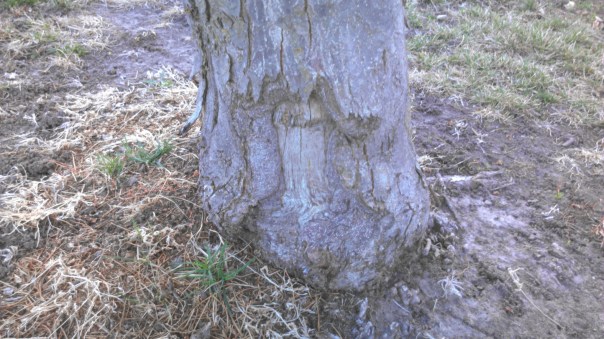
This is the most common problem I see with tree calls. A huge enemy to trees are weed whackers! In this case, you can see extensive damage to the bark and the base of this tree. Depending on the damage and how well the tree can seal the wound will depend on if the tree will survive or not. Often, as in the case of this tree, the tree will be weakened with few leaves appearing on branches. It’s best to place mulch around trees in order to avoid having to use weed whackers on them-but again, don’t place the mulch up against the base of the tree!
This was a fun workshop for me with the right size of group and great hands-on demonstration where we also learned from pruning mistakes and how best to correct them. Thanks again Scott!
Central Nebraska Extension Master Gardener Program
Interested in plants and gardening? Check out this information about the Master Gardening Program from Elizabeth Killinger, UNL Extension Educator!
New blog posted at http://huskerhort.wordpress.com/ about The Nebraska Extension Master Gardener Program
 Do you enjoy plants and gardening? Looking to learn more and hone your skills but don’t know where to go? The Master Gardener program will educate you on many aspects of horticulture, allow you to test your knowledge and skills, all while serving your local community.
Do you enjoy plants and gardening? Looking to learn more and hone your skills but don’t know where to go? The Master Gardener program will educate you on many aspects of horticulture, allow you to test your knowledge and skills, all while serving your local community.
The Nebraska Extension Master Gardener program is a horticulture related volunteer training program based in many counties throughout the state. It has been part of University of Nebraska- Lincoln (UNL) Extension since 1976. Master Gardener volunteers are trained by UNL Extension faculty and staff. They contribute time as volunteers working with their local Extension office to provide horticulture-related information to their community. Participants are required to complete 40 hours of training and 40 hours of volunteer service during the initial year of their involvement in the program. Master Gardener volunteers retain their…
View original post 376 more words



